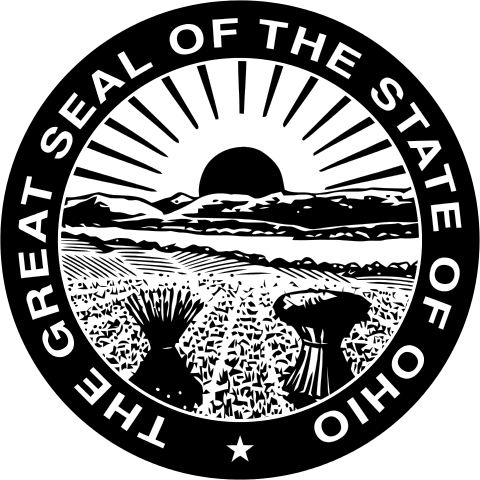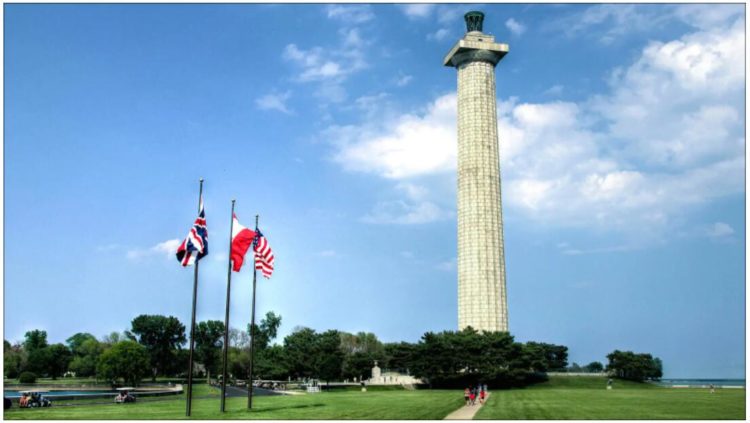Ohio is a state in the American Midwest. It is bounded to the north by Lake Erie, which forms the border with neighboring Canada, and to the south by the Ohio River, which gave Ohio its name. The name comes from the Iroquois language and means “great river”.
The capital of Ohio is Columbus ; other major cities are Cleveland, Cincinnati, Toledo, Akron and Dayton. The nickname Ohio is “Buckeye State” (Buckeye tree = Ohio horse chestnut).
| Area | 116,096 km² |
| Residents | 11,614,373 |
| Residents per km² | 100 |
| Capital | Columbus |
| Postal Code | OH |
| ISO-3166-2 code | US OH |
| FIPS code | 39 |
Geography
Ohio is located in the American Midwest between Pennsylvania in the east, West Virginia in the southeast, Kentucky in the southwest, Indiana in the west and Michigan and Lake Erie in the north. In Lake Erie, Ohio borders the Canadian province of Ontario. The borders with West Virginia and Kentucky form the north bank of the Ohio River after its course from 1792, the borders with Indiana and Pennsylvania run exactly north-south. The border with Michigan was originally supposed to run exactly west-east on the geographical latitude of the southern tip of Lake Michigan.
History
When the whites arrived, the region between the Ohio River and the Great Lakes, where Ohio is today, was inhabited by various Indian tribes, including the Miami, Wyandot, Shawnee, Lenni Lenape, Ottawa and Erie. During the colonization of North America by Europeans, Iroquois from what is now New York State claimed the area.
In the 18th century France set up a system of trading posts there to control trade between Europeans and Indians. In 1763, France ceded control of what is now Ohio to the British.
Settling the newly won land was initially prohibited by a royal proclamation. However, this lost its validity after the American independence from the British Crown, whereupon the Northwest Territory was opened up in 1787, which in addition to the area of today’s Ohio also included the areas of other states. The new territory was the first in the United States to officially outlaw slavery. In anticipation of the upcoming founding of the state, the Indiana Territory was later founded, which only comprised present-day Ohio and parts of present-day Michigan.
On February 19, 1803, Ohio was admitted as the 17th state to the United States by US President Thomas Jefferson. Since an official accession date for new states had only been determined by Congress since 1812, US President Eisenhower set it as March 1, 1803 in 1953.
In 1835 Ohio waged the so-called Toledo War (a war without dead people), in which it fought with the Michigan Territory for the area around the city of Toledo. After the intervention of Congress, the Michigan Territory renounced the so-called Toledo Strip and in return was awarded parts of the upper Michigan Peninsula, whose mineral wealth was not yet known at the time.
Ohio’s central position played an important role in the civil war. Historian Andrew RL Cayton estimates that a total of 35,000 Ohio citizens died in the war. The major Union generals Ulysses S. Grant, William Tecumseh Sherman, and Philip Sheridan were all from Ohio.
In the Kent State Massacre (English Kent State Shootings, Kent State Massacre) on May 4, 1970 at Kent State University in the United States, four students were shot and nine, some seriously injured, when the Ohio State National Guard during a demonstration against Vietnam War opened fire on the crowd of unarmed protesters. To date, no one has been held responsible for it.
Economy
The economic output of Ohio in the year 2016 was 625 billion USD making it the seventh highest economic output of the states of the USA and a share of 3.39% of the total American economy. Counted as a separate country, Ohio’s economic output would be roughly the same as that of Saudi Arabia.
The real gross domestic product per capita real GDP was USD 53,609 in 2016 (national average of the 50 US states: USD 57,118; national ranking: 25). The unemployment rate was 4.8% in November 2017 (national average: 4.1%).
Ohio is one of the leading locations for mechanical engineering in the USA. Industrial production also includes means of transport, metal processing, machines, tools, rubber products, foodstuffs and electrical appliances.
With large sediments, mostly shale, of gas and oil, Ohio benefited significantly from the fracking boom in the US in the 2010s.
As part of the Corn Belt, the agricultural sector plays a major role. Agricultural production includes soybeans, dairy products, corn, tomatoes, cattle for slaughter (pigs, cattle), poultry and eggs. Commercial fishing is carried out on Lake Erie.
With over 2,500 lakes and 72,000 kilometers of river, because of its varied landscape, its recreational areas and historical sights (especially archaeological sites – excavations of Indian settlements and burial sites) Ohio is interesting for tourists, and tourism is one of the growth industries.
Also known as Buckeye State, Ohio is short for OH with a population of 11,353,140. The capital city and the biggest city of Ohio is Columbus.

